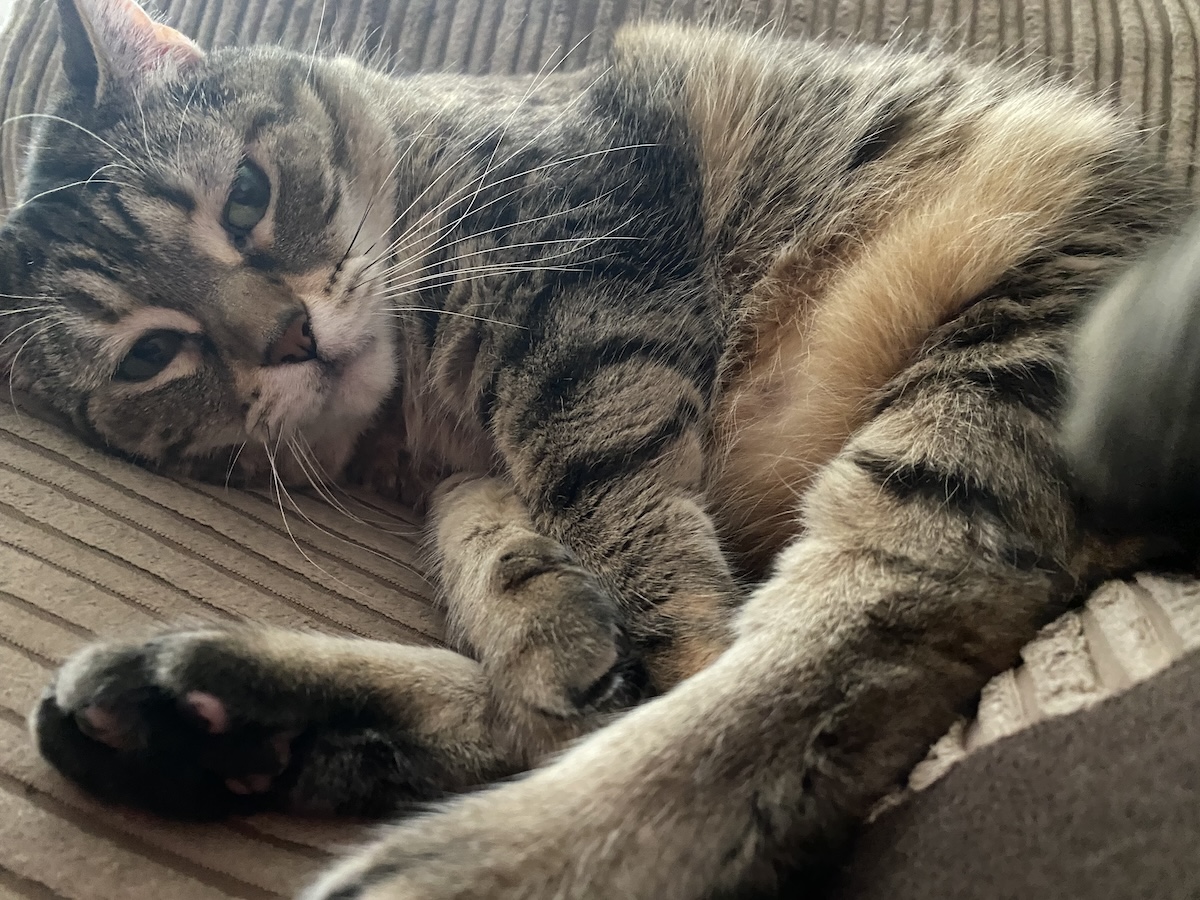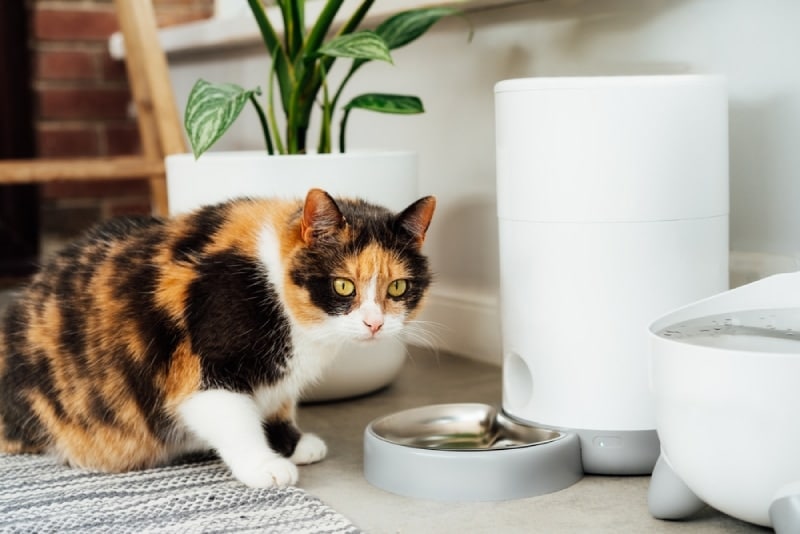
To help you find the perfect match for your kitty companion, we’ve compiled a list of the best automatic cat feeders based on reviews. Let’s get right to it!
A Quick Comparison of Our Favorites in 2024
| Image | Product | Details | ||
|---|---|---|---|---|
| Best Overall |

|
Petlibro Granary Automatic Two Cat Feeder |
|
CHECK PRICE |
| Best Value |

|
Cat Mate C3000 Automatic Cat Feeder |
|
CHECK PRICE |
| Premium Choice |

|
Petlibro Granary Automatic Cat Feeder with Camera |
|
CHECK PRICE |
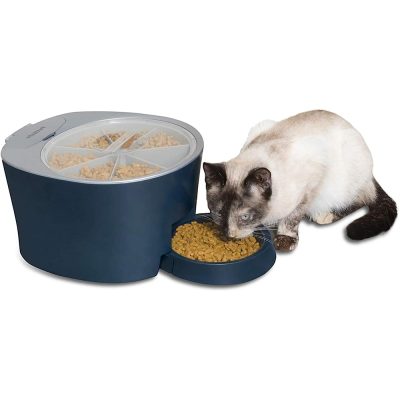
|
PetSafe 6-Meal Automatic Cat Feeder |
|
CHECK PRICE | |

|
Arf Pets Automatic Cat Feeder |
|
CHECK PRICE |
The 10 Best Automatic Cat Feeders
1. Petlibro Granary Automatic Two Cat Feeder – Best Overall

| Dimensions: | 14.17 x 7.72 x 10.16 inches |
| Bowl & Storage Feature: | Automatic |
| Capacity: | 5 L |
| Material: | Plastic |
The Petlibro Granary Automatic Two Cat Feeder stands out as the best overall automatic cat feeder this year, particularly because of its balance between functionality and ease-of-use. The feeder is fully programmable, allowing owners to have precise control over feeding schedules. It can dispense up to five meals per day, with each meal portion being individually adjustable.
The user-friendly LED control panel makes navigation simple and straightforward. Beyond the control panel, the entire system, including the top lid and bowl, is dishwasher safe. This makes cleaning the feeder a hassle-free process. Additionally, the feeder’s large 5-liter food hopper can store enough kibble to last for weeks, ensuring your cats are well-fed even when you’re away.
Despite a few minor drawbacks, such as slightly noisy dispensing and somewhat challenging button pressing due to its pet-proof design, the Petlibro Granary Automatic Two Cat Feeder offers robust features and exceptional usability.
- Dishwasher safe
- Large capacity for those with multiple cats
- Easy to use and program
- Stores enough kibble for 2 weeks
- Does not come with a power adapter
- Slightly noisy
2. Cat Mate C3000 Automatic Cat Feeder – Best Value

| Dimensions: | 13.6 x 8.7 x 15.2 inches |
| Bowl & Storage Feature: | Automatic, Dry, Wet/Canned Food |
| Capacity: | 26 cup |
| Material: | Plastic |
Offering outstanding value for money, the Cat Mate C3000 Automatic Cat Feeder is a great choice for pet owners. The feeder can feed your pet up to three times a day with a single bowl, making it ideal for those with multiple pets or medium-sized breeds. The digital LCD display and user-friendly programming provide complete control over the feeding process.
One unique feature of the Cat Mate C3000 is its ability to store both wet and dry food simultaneously. This adds extra convenience for pet owners and ensures that your pets are receiving a balanced diet. The feeder’s 26-cup capacity also makes it suitable for owners with several pets or medium-sized breeds.
While there are a few downsides, such as the noise it makes when dispensing food and the manual reset required after a power failure, these are minor when compared to the value it offers. With its range of features and simple setup process, this model is ideal for those looking to purchase an automatic cat feeder at a reasonable price and gets our vote for the best automatic cat feeder for the money.
- User-friendly programming
- Multiple food type options available
- Ability to store wet and dry food simultaneously
- Loud sound when dispensing
- Manual reset required after power failure
3. Petlibro Granary Automatic Cat Feeder with Camera – Premium Choice

| Dimensions: | 12.2 x 13.6 x 16.7 inches |
| Bowl & Storage Feature: | Automatic, Dry Food Only |
| Capacity: | 10 cup |
| Material: | Plastic and Stainless Steel |
Taking automatic pet feeding to the next level, the Petlibro Granary Automatic Cat Feeder with Camera provides full system monitoring with its 1080P HD camera and two-way audio. This high-tech feeder allows you to supervise your cats’ mealtimes from anywhere, giving you peace of mind about their wellbeing.
The feeder can dispense up to 10 meals per day, with each portion adjustable according to your pets’ needs. The control panel is user-friendly, and the accompanying app lets you set specific feeding times and check food levels. While the feeder can accommodate both wet and dry food, it only dispenses dry kibble due to its pet-proof design.
Despite minor drawbacks like the camera being active only before and after meals and slightly challenging buttons, the Petlibro Granary Automatic Cat Feeder with Camera stands out as a premium choice. Its smart technology, intuitive programming, and reliable performance make it a worthwhile investment for pet owners.
- Easy to use and program
- Large capacity for multiple cats
- Full system monitoring with the app
- Pricey
- Camera cannot be used during meal times
4. PetSafe 6-Meal Automatic Cat Feeder, Blue – Best for Kittens
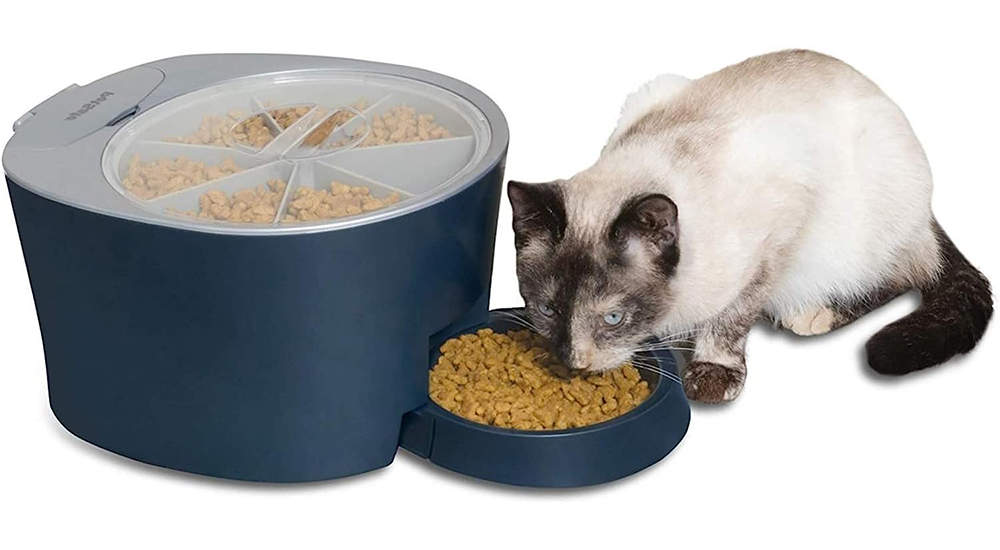
| Dimensions: | 10.3 x 15 x 3.1 inches |
| Bowl & Storage Feature: | Automatic |
| Capacity: | 6 meal |
| Material: | Plastic |
For smaller pets such as kittens or puppies, the PetSafe 6-Meal Automatic Cat Feeder is a top choice. Its compact size and user-friendly features make it ideal for feeding smaller pets, ensuring they get the right amount of food at the right time. The feeder’s digital timer allows you to schedule up to six meals per day.
The dishwasher-safe food trays add to its convenience, making the cleaning process simple and easy. This means you can spend less time worrying about your pet’s meals and more time enjoying their company. However, this feeder may not be suitable for large-sized kibble, which is something to keep in mind if your pet prefers larger bites.
Despite its limitation with kibble size, the PetSafe 6-Meal Automatic Cat Feeder is an excellent choice for owners of small pets. Its combination of compact size, easy-to-use features, and flexibility in meal scheduling make it a standout choice for kittens.
- Easy to use and clean
- Dishwasher safe
- Suitable for both wet and dry food
- Not suitable for large-sized kibble
5. Arf Pets Automatic Cat Feeder

| Dimensions: | 9.65 x 11.8 x 15 inches |
| Bowl & Storage Feature: | Automatic |
| Capacity: | 1.14 gallon |
| Material: | Plastic |
The Arf Pets Automatic Cat Feeder is a versatile and user-friendly option that is suitable for all life stages of your pet. With a large capacity of 1.14 gallons, it can serve up to four meals per day. This makes it a great choice for pet owners who are often away from home during mealtimes.
One of its standout features is the programmable feeder and personal meal call recorder, which adds a touch of personalization to the feeding experience. Unfortunately, this feeder is not suitable for wet food, limiting its versatility somewhat. However, for dry food, it does an excellent job of consistently dispensing meals.
While it may not be perfect for every situation, the Arf Pets Automatic Cat Feeder is a solid choice for any pet owner. Its large capacity, programmability, and additional features make it a valuable addition to any home with pets.
- Can serve up to four meals per day
- Easy to clean
- Not suitable for wet food
6. Closer Pets Five-Meal Automatic Cat Feeder with Digital Timer

| Dimensions: | 13 x 2.9 x 14.6 inches |
| Bowl & Storage Feature: | Automatic |
| Capacity: | 5 meal |
| Material: | Plastic |
If you need to feed your pets several small meals throughout the day, the Closer Pets Five-meal Automatic Cat Feeder is a practical option. With its digital timer and five one-cup portion sections, you have complete control over your pet’s feeding schedule. This ensures your pet is getting the right amount of food at the right times.
The feeder is also easy to clean, thanks to its dishwasher-safe food tray. This helps to maintain hygiene and keeps your pet healthy. However, it might not be the best choice for large breeds or households with multiple pets, due to its limited capacity.
Despite this, the Closer Pets Five-meal Automatic Cat Feeder is an excellent choice for pet owners who need to provide multiple small meals throughout the day. Its ease of use, cleanliness, and controlled portions make it a valuable tool for any pet owner.
- Easy to use and program
- Large capacity for multiple cats
- Full system monitoring with the app
- Camera cannot be used during meal times
- May not be ideal for multiple cats
7. DOGNESS Automatic Cat Feeder

| Dimensions: | 8.4 x 16.5 x 16.3 inches |
| Bowl & Storage Feature: | Automatic |
| Capacity: | 6.5 pounds |
| Material: | Plastic |
The DOGNESS Automatic Cat Feeder is a worthwhile option for pet owners seeking a feeder with a large capacity. This model can hold up to 6.5 pounds of dry food, making it ideal for households with multiple pets or larger breeds. Its programmable features allow you to customize your pet’s feeding schedule according to their needs.
One unique feature of this feeder is the voice recorder, which allows you to record a personalized message for your pet. This adds a touch of warmth and familiarity to mealtimes, even when you’re not around. However, this feeder isn’t suitable for wet food, limiting its use to dry kibble only.
Despite its limitation with wet food, the DOGNESS Automatic Cat Feeder is an excellent choice for those needing a large-capacity feeder. With customizable feeding schedules and a voice recorder, this feeder offers convenience and personalization in one package.
- Large capacity
- Suitable for dry food
- Easy to program
- Not suitable for wet food
8. PortionPro Rx Automated RFID Cat Feeder

| Dimensions: | 18 x 13 x 16 inches |
| Bowl & Storage Feature: | Automatic |
| Capacity: | 32 oz. |
| Material: | Plastic |
The PortionPro Rx Automated RFID Cat Feeder is a high-tech solution that uses RFID technology to prevent food stealing among pets. The feeder ensures each pet gets their designated portion, making it ideal for multi-pet households. The programmable feeder also allows you to easily set up your pet’s feeding schedule.
However, like many automatic feeders, the PortionPro Rx is not suitable for wet food. It’s designed specifically for dry kibble, which may not suit all pets’ dietary requirements. Despite this, the advanced technology and ease of use make it a standout choice for pet owners.
Despite its limitations with wet food, if you’re looking for a tech-driven solution to manage your pets’ meals effectively, the PortionPro Rx Automated RFID Cat Feeder is a solid choice. Its unique use of RFID technology and programmability make it a valuable asset in any multi-pet household.
- Prevents food stealing
- Suitable for dry food
- Easy to program
- Not suitable for wet food
9. INSTACHEW Purechew Mini Automatic Stainless Steel Smart Pet Feeder

| Dimensions: | 14.6 x 12 x 8.7 inches |
| Bowl & Storage Feature: | Automatic |
| Capacity: | 94 oz. |
| Material: | Stainless Steel |
For pet owners who value convenience and hygiene, the INSTACHEW Purechew Mini Automatic Stainless Steel Smart Pet Feeder is an excellent choice. With a large 94-ounce capacity and stainless steel construction, it’s both large enough for multiple pets and easy to clean.
The feeder’s programmable features, portion control, and voice recorder provide flexibility in managing your pet’s feeding schedule. However, like many automatic feeders, this model is not suitable for wet food. Despite this, its convenience, hygiene, and large capacity make it a worthy consideration.
Despite its limitations with wet food, the INSTACHEW Purechew Mini Automatic Stainless Steel Smart Pet Feeder is a great choice for those prioritizing convenience and hygiene. With its large capacity, easy cleaning, and customizable feeding options, it’s a strong contender in the automatic pet feeder market.
- Large capacity
- Suitable for dry food
- Easy to clean
- Not suitable for wet food
10. Petlibro Granary Automatic Cat Feeder

| Dimensions: | 17.5 x 11.5 x 7.5 inches |
| Bowl & Storage Feature: | Automatic |
| Capacity: | 4 L |
| Material: | Plastic |
Lastly, the Petlibro Granary Automatic Cat Feeder is a reliable and user-friendly option for pet owners. With a large 4-liter capacity and a variety of customizable feeding options, this feeder ensures your pets are well-fed even when you’re away.
The feeder’s portion control and voice recorder features add a level of convenience and personalization to your pet’s feeding experience. However, like many automatic feeders, this model is not suitable for wet food. Nonetheless, for dry kibble, it offers reliable performance and user-friendly operation.
Despite its limitation with wet food, the Petlibro Granary Automatic Cat Feeder is an excellent choice for any pet owner. Its large capacity, customizable feeding options, and user-friendly design make it a valuable addition to any pet-filled home.
- Large capacity
- Suitable for dry food
- Easy to program
- Not suitable for wet food
Buyer’s Guide: Choosing the Best Automatic Cat Feeder
What Is an Automatic Cat Feeder?
An automatic cat feeder is a device that dispenses food for your cat at preset times and portions. It’s ideal for pet owners who are often away from home or want to manage their pet’s feeding schedule more effectively.
Alternatively, you could invest in food and water dishes that are both functional for your cat and beautiful for your home. Designed with your cat's well-being in mind, the Hepper NomNom Cat Bowl takes a modern spin on traditional cat dishes and is aimed at offering the utmost comfort and support to cats of all ages, sizes, and breeds. It's spillproof, dishwasher safe, and comprised of cat-safe materials. Learn more about the NomNom Cat Bowl here. At Catster, we’ve admired Hepper for many years and decided to take a controlling ownership interest so that we could benefit from the outstanding designs of this cool cat company!
How Does an Automatic Cat Feeder Work?
An automatic cat feeder works by dispensing a predetermined amount of food at specific times during the day. You can program the feeder to dispense food at certain intervals, ensuring your cat gets fed even when you’re not around.
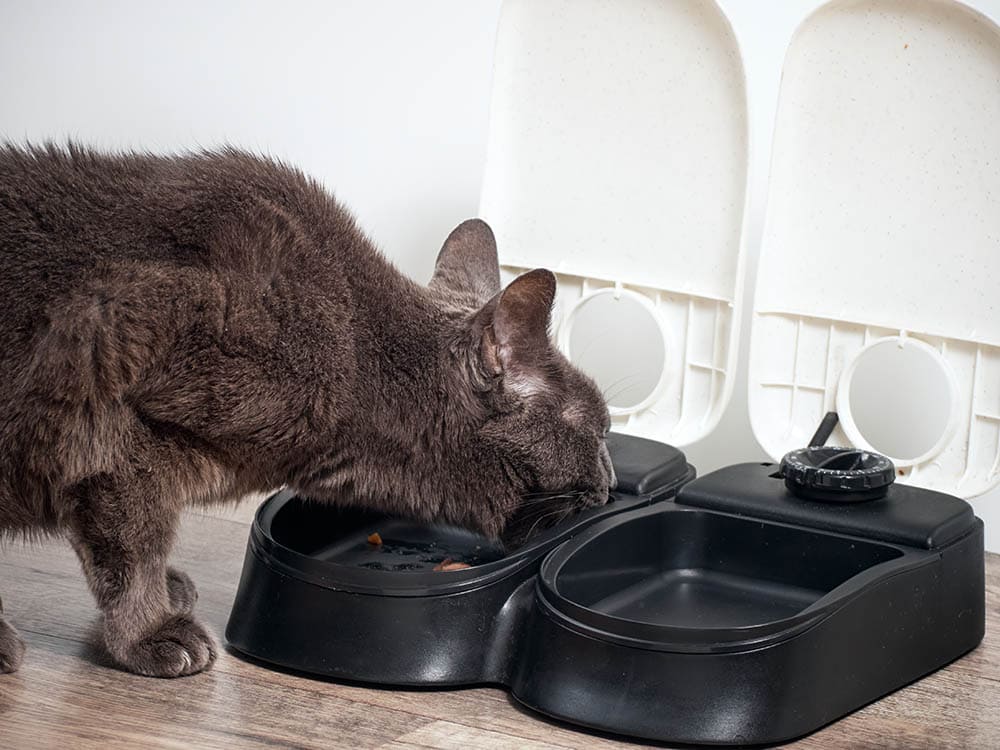
What to Look for in an Automatic Cat Feeder
Capacity
The capacity of the feeder determines how much food it can hold. If you have multiple cats or a larger breed, you might need a feeder with a larger capacity.
Type of Food
Some automatic feeders are designed to dispense dry food, while others can handle both dry and wet food. Consider your cat’s dietary needs when choosing a feeder.
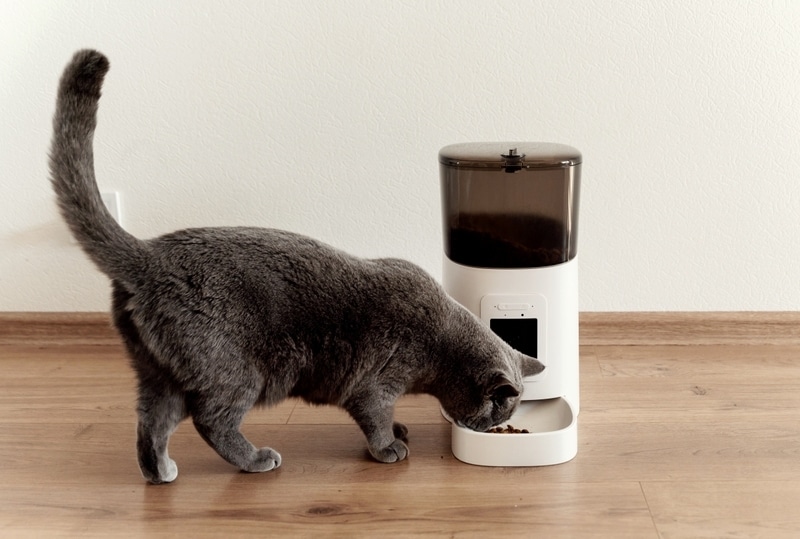
Programming Options
Automatic feeders come with different programming options. Some allow you to schedule multiple meals throughout the day, while others offer portion control features.
Power Source
Automatic feeders can be battery-operated, corded, or both. A feeder with dual power options can provide a backup in case one power source fails.
Ease of Cleaning
Look for a feeder that is easy to clean to maintain hygiene. Some models have removable parts that are dishwasher safe.
Durability
A good automatic cat feeder should be durable and able to withstand your cat’s attempts to access more food.

Noise Level
Some automatic feeders can be noisy, which may scare off sensitive cats. Check the noise level before making a purchase.
Design
The design of the feeder should be user-friendly, with a clear display and easy-to-use buttons for programming meals.
Special Features
Some automatic feeders come with special features such as a slow-feed option, voice recording, or a camera for monitoring your pet.
Price
Last but not least, consider your budget. Automatic cat feeders come in a wide range of prices, so choose one that offers the features you need at a price you’re comfortable with.
Tips for Success When Switching to an Automatic Cat Feeder
- Gradual Transition: Start by using the automatic feeder alongside your regular feeding routine before completely switching over. This helps your cat get used to the new device.
- Consistent Mealtimes: Program the feeder to dispense food at the same times that you usually feed your cat. This maintains consistency and helps your cat adjust to the new feeding method.
- Correct Portion Sizes: Make sure you’re dispensing the right amount of food for your cat’s size, age, and health status. Overfeeding can lead to obesity and other health issues.
- Quality Food: Just because you’re using an automatic feeder doesn’t mean you should compromise on the quality of your cat’s food. Continue to provide a balanced and nutritious diet.
- Regular Cleaning: Keep the feeder clean to prevent bacteria buildup. Many automatic feeders have dishwasher-safe parts for easy cleaning.
- Backup Power Source: If your automatic feeder is electric, ensure it has a backup power source like batteries in case of a power outage.
- Monitor Your Cat’s Eating Habits: Even with an automatic feeder, it’s important to monitor your cat’s eating habits. If your cat is eating less or more than usual, it could be a sign of health issues.
- Familiarize Your Cat: Let your cat inspect the new feeder before you start using it. The unfamiliar object might initially scare them, but they’ll get used to it over time.
- Use the Special Features: If your automatic feeder has special features like voice recording, use them to make the feeding experience more pleasant for your cat.
- Regularly Refill the Feeder: Even with a large-capacity feeder, make sure to check the food levels regularly and refill it as needed. Running out of food can be stressful for your cat.
Conclusion
After thorough reviews, the Petlibro Granary Automatic Two Cat Feeder emerges as the best overall choice for its user-friendly features and large capacity. For those seeking value, the Cat Mate Automatic Cat Feeder offers excellent functionality at a great price point. If you’re looking for premium features, consider the Petlibro Granary Automatic Cat Feeder with Camera for its advanced monitoring capabilities. These top picks not only cater to a variety of needs but also provide reliable performance, ensuring your pets are well-fed and happy.
Featured Image Credit: Okrasiuk, Shutterstock
Contents
- A Quick Comparison of Our Favorites in 2024
- The 10 Best Automatic Cat Feeders
- 1. Petlibro Granary Automatic Two Cat Feeder – Best Overall
- 2. Cat Mate C3000 Automatic Cat Feeder – Best Value
- 3. Petlibro Granary Automatic Cat Feeder with Camera – Premium Choice
- 4. PetSafe 6-Meal Automatic Cat Feeder, Blue – Best for Kittens
- 5. Arf Pets Automatic Cat Feeder
- 6. Closer Pets Five-Meal Automatic Cat Feeder with Digital Timer
- 7. DOGNESS Automatic Cat Feeder
- 8. PortionPro Rx Automated RFID Cat Feeder
- 9. INSTACHEW Purechew Mini Automatic Stainless Steel Smart Pet Feeder
- 10. Petlibro Granary Automatic Cat Feeder
- Buyer’s Guide: Choosing the Best Automatic Cat Feeder
- What Is an Automatic Cat Feeder?
- How Does an Automatic Cat Feeder Work?
- What to Look for in an Automatic Cat Feeder
- Tips for Success When Switching to an Automatic Cat Feeder
- Conclusion













